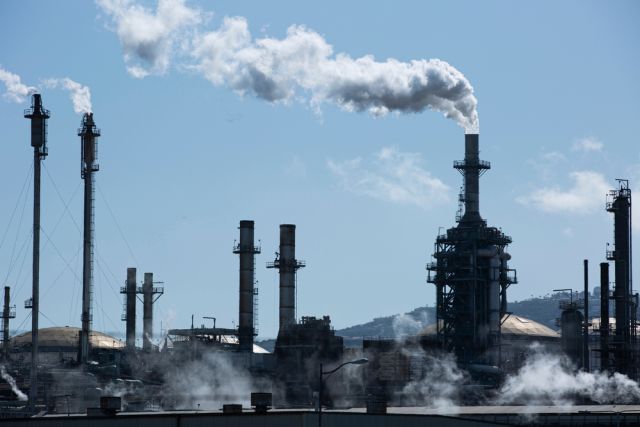
Alongside being imperceptible to the eye, gases are being emitted from hundreds of thousands of equipment pieces at sites. (Source: Shutterstock)
Perhaps it’s only inevitable that combating the widespread chaos of emissions leaks requires the talents of a mind that doesn’t work like a human’s.
“Emissions work is hard,” Raoul LeBlanc, vice president of research and analysis at S&P Global Commodity Insights, said during a recent AWS Energy Symposium.
“You’re trying to measure something that’s invisible and sometimes comes out on purpose and other times comes out on accident.”
Alongside being imperceptible to the eye, gases are being emitted from hundreds of thousands of equipment pieces at sites—each piece being unique—causing operators to deal with an enormous amount of heterogeneity. LeBlanc said operators in the energy space are not utilizing proper tools when attempting to measure and track emissions.
“We’re using a flathead screwdriver on a Phillips screw,” LeBlanc said. “Most of the data systems and the IT infrastructure that was set up was done to do oil and gas measurements and all of a sudden they’re being repurposed.”

S&P believes the have a multipurpose tool that can help. Call it an artificial intelligence and machine-learning screwdriver.
But challenges remain and the scale of the problem is daunting.
The repurposing of tools originally used for standard oil and gas operations has caused issues for many operators. It can be difficult to gather, measure or interpret information without using the proper tools. The collected data either won’t be as precise or not acquired in the most efficient manner.
Another problem is the constantly changing regulatory standards and dynamics within t industry that turned the sector into the “Wild, Wild West,” he said. With the continually changing parameters preventing a standard way to collect emissions data, companies experience large amounts of “data headaches.”
These “data headaches” are further exacerbated by the dearth of new ideas when it comes to emissions management.
“You’re trying to lower emissions, and the problem is you started with the right stuff, which is the no-brainer [solutions], but now you’re starting to run out of ideas,” LeBlanc said. “All the low hanging fruit are starting to get picked and now you’re going to have to start spending real dollars.”
And while nearly every company is hard at work, inventing new data models and creating new algorithms, they oftentimes end up with the exact same solutions. S&P is working to create a solution that remedies all.
“We’re trying to create an environment in which companies can put in their proprietary confidential data and trust that we’re going to anonymize it to an degree that it can drive real models that really work to give them insight so that everybody doesn’t have to do this for themselves,” LeBlanc said.
But LeBlanc admits that there has been “no easy button” when it comes to adoption as intracompany disconnect has popped up amongst those looking to use S&P’s solution.
“You go to the people at the working level, and they’re mostly like, we are never giving away this information,” he said. “And then you go up and you start talking to the C-suite and they say, ‘You know what? We’re willing to do it.’”
LeBlanc hopes companies begin to see eye to eye as emissions is the one place where collaboration is useful, he said.
“This is a deal where you could look around at other companies and see what they have done in a similar type of asset, and apply that,” LeBlanc said. “And then we do some digital twins where I predict what the emissions for a site ought to be, and then I look at what they actually are and bam, I have outliers. That’s where I want to spend my money. That’s where I want to start my work.”
Even with the benefits of sharing information in emissions management, operators are still lacking in preparation.
“The real reason they’re unwilling to put in their data most of the time is that they have initiative overload, and they are always busy and understaffed trying to get the data together. So they tell us, our data’s not ready for this. We would love to participate in this, but our data’s not ready and it’s difficult,” LeBlanc said.
S&P’s machine learning capabilities can help operators understand their emissions by truly “lifting the hood and looking at the engine,” helping them quantify why their assets emit the way they do.
Machine learning can also enhance an operator’s predictive capabilities, allowing them to create predictive models with 10 time the data. S&P’s solution will also help with optimization as the machine would be able to search its database, find similar assets throughout the world and study what made those assets successful.
“If you can reduce your per ton cost of carbon abatement from $80 to $70 or $65, it is an enormous amount of money over the long term,” he said. “We had one company said, yeah, our plan is to spend $2 billion by 2030 to hit our goal. And imagine if you can save five, 10% of that. It starts to be quite real in terms of the money.”
LeBlanc wants to turn emissions reporting from a cost center to a value center for operators, by taking the exhaust of their monitored and measured data and allowing operators worldwide to analyze it and capitalize from it.
“As you run out of that low hanging fruit, you’re going to have to try a bunch of new things for the first time. Your company is going to have to do some things for the first time,” LeBlanc said. “Wouldn’t that be amazing if you could figure out what happened to the other people and you’re not flying blind?”
Recommended Reading
Baker Hughes: US Drillers Add Oil, Gas Rigs for Third Week in a Row
2025-02-14 - U.S. energy firms added oil and natural gas rigs for a third week in a row for the first time since December 2023.
US Drillers Add Oil, Gas Rigs for First Time in Eight Weeks
2025-01-31 - For January, total oil and gas rigs fell by seven, the most in a month since June, with both oil and gas rigs down by four in January.
US Oil Rig Count Rises to Highest Since June
2025-04-04 - Baker Hughes said oil rigs rose by five to 489 this week, their highest since June, while gas rigs fell by seven, the most in a week since May 2023, to 96, their lowest since September.
US Oil and Gas Rig Count Rises to Highest Since June, Says Baker Hughes
2025-02-21 - Despite this week's rig increase, Baker Hughes said the total count was still down 34, or 5% below this time last year.
Baker Hughes, Frontier Form CCS, Powergen Partnership
2025-03-03 - Baker Hughes will provide technology solutions to support the Sweetwater Carbon Storage Hub being developed by Frontier Infrastructure in Wyoming.
Comments
Add new comment
This conversation is moderated according to Hart Energy community rules. Please read the rules before joining the discussion. If you’re experiencing any technical problems, please contact our customer care team.

